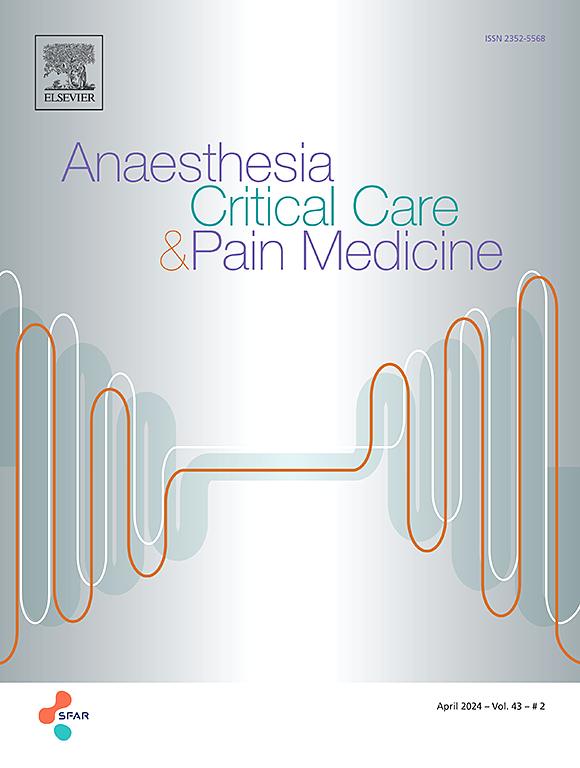Longitudinal changes of electrical impedance tomography-based best PEEP in obese patients undergoing laparoscopic surgery: A prospective physiological study
IF 4.7
3区 医学
Q1 ANESTHESIOLOGY
引用次数: 0
Abstract
Background
During laparoscopic surgery, there is an increased tendency for lung collapse. Individualized PEEP has shown possible advantages in obese patients undergoing laparoscopic procedures, but the optimal timing for titration and the evolution of lung regional mechanics have not been extensively explored.
Methods
Patients with Class I/II Obesity undergoing laparoscopic surgery for abdominal procedures were monitored using 16 electrodes Electrical Impedance Tomography (EIT) and underwent a decremental PEEP titration trial at 3 timepoints: after anesthesia induction (T1), after positioning and pneumoperitoneum (T2) and after laparoscopy (T3). EIT-derived lung regional collapse (EITCO) and overdistension (EITOD) were recorded, as well as respiratory mechanics, hemodynamic and surgical data. The best PEEP according to EIT (PEEPEIT) was calculated at each timepoint as the intersection between regional collapse and overdistention.
Results
We enrolled 31 patients with a median age of 63 [49−74] years and a BMI of 36 [32−37] kg m−1. During surgery, PEEPEIT at T1 and T2 were respectively 10[9–11.5] and 13.9[12.6–15] cmH2O (p < 0.001), with a median increase of 3 [2–4] cmH2O, a range of increase of 0–7 cmH2O and a coefficient of increase variation of 60.8%. The difference in PEEPEIT between T2 and T1 did not correlate with intrabdominal pressure (r = −0.03, p = 0.88), while a significant association was found with trunk inclination (p = 0.018, r = 0.42).
Conclusions
EIT-based best PEEP changes dynamically and non-homogeneously during laparoscopic surgery in class I/II obese patients. PEEP reassessment is required to guarantee the application of protective mechanical ventilation throughout the entire course of anesthesia.
Registration
clinicaltrials.gov under number NCT05554536.
基于电阻抗断层扫描的肥胖患者腹腔镜手术最佳PEEP的纵向变化:一项前瞻性生理研究。
背景:在腹腔镜手术中,肺塌陷的趋势增加。个体化PEEP在接受腹腔镜手术的肥胖患者中显示出可能的优势,但最佳的滴定时间和肺区域力学的演变尚未得到广泛的探讨。方法:采用16电极电阻抗断层扫描(EIT)监测腹腔镜下腹部手术的I/II类肥胖患者,并在麻醉诱导后(T1)、体位气腹后(T2)和腹腔镜手术后(T3) 3个时间点进行递减PEEP滴定试验。记录eit引起的肺区域性塌陷(EITCO)和过度扩张(EITOD),以及呼吸力学、血流动力学和手术数据。根据EIT计算出各时间点的最佳PEEP (PEEPEIT),作为局部塌陷与过胀的交集。结果:我们纳入了31例患者,中位年龄为63[49-74]岁,BMI为36 [32-37]kg m-1。术中T1、T2时PEEPEIT分别为10[9-11.5]、13.9[12.6-15]cmH2O (p 2O),升高范围为0-7 cmH2O,升高变异系数为60.8%。T2和T1之间PEEPEIT的差异与腹内压无相关性(r=-0.03, p = 0.88),而与躯干倾斜度有显著相关性(p = 0.018, r=0.42)。结论:在I/II类肥胖患者腹腔镜手术过程中,基于eit的最佳PEEP动态且非均匀变化。为了保证整个麻醉过程中保护性机械通气的应用,需要重新评估PEEP。注册:ClinicalTrials.gov,注册号NCT05554536。
本文章由计算机程序翻译,如有差异,请以英文原文为准。
求助全文
约1分钟内获得全文
求助全文
来源期刊

Anaesthesia Critical Care & Pain Medicine
ANESTHESIOLOGY-
CiteScore
6.70
自引率
5.50%
发文量
150
审稿时长
18 days
期刊介绍:
Anaesthesia, Critical Care & Pain Medicine (formerly Annales Françaises d''Anesthésie et de Réanimation) publishes in English the highest quality original material, both scientific and clinical, on all aspects of anaesthesia, critical care & pain medicine.
 求助内容:
求助内容: 应助结果提醒方式:
应助结果提醒方式:


